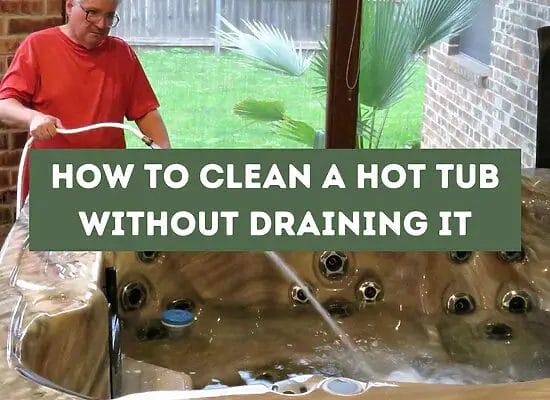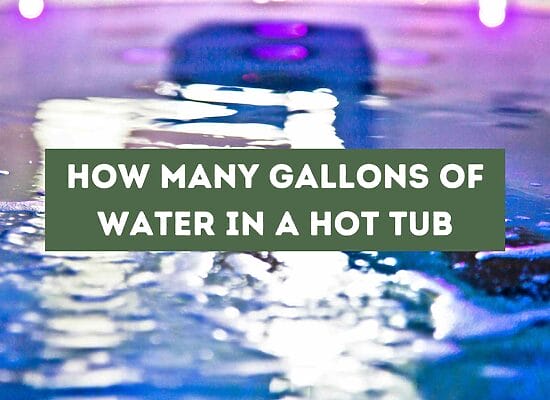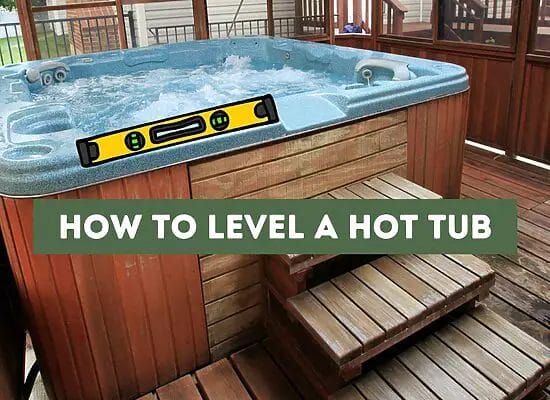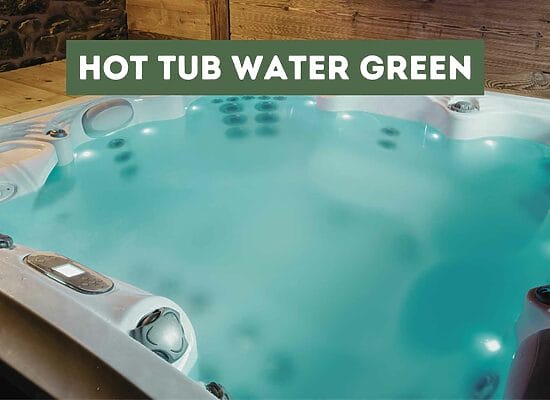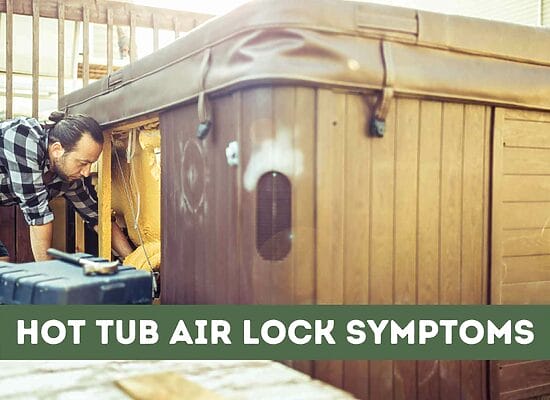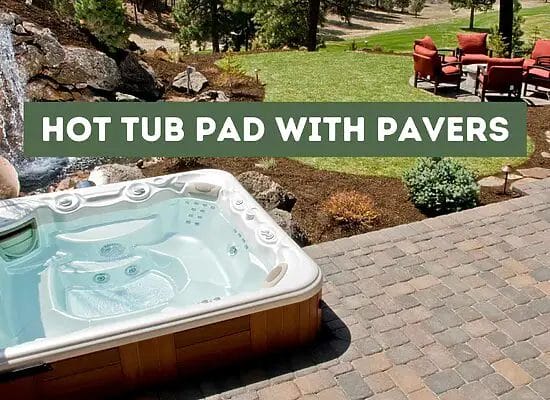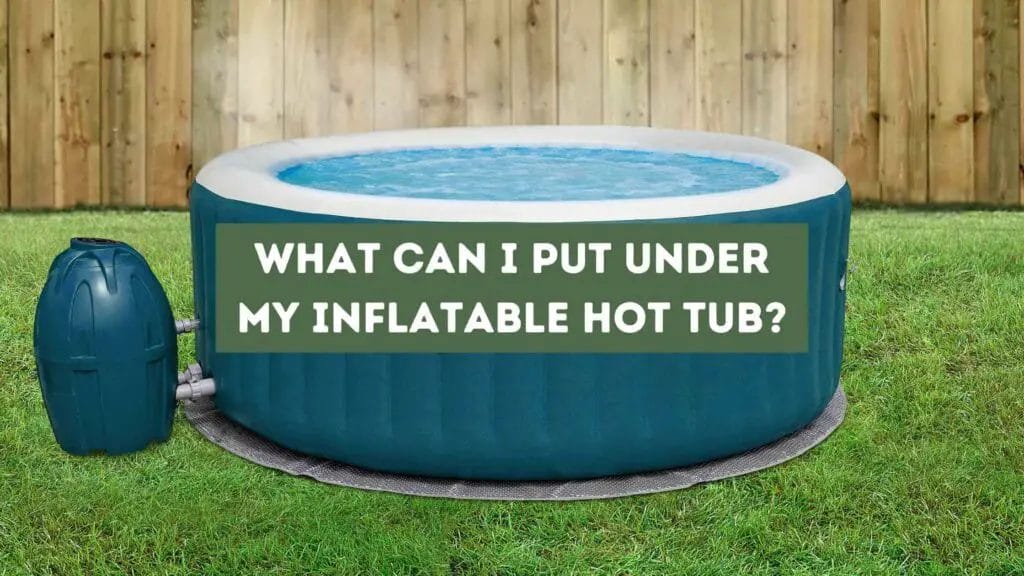
Are you a proud owner of an inflatable hot tub? If so, you might be wondering what to put under it to ensure its longevity and stability. Fortunately, there are several options available to you, each with its own advantages and disadvantages. Below, we’ll explore the different materials you can use to create a solid base for your hot tub so you can enjoy it for years to come.
Key takeaways:
- Importance of a Solid Base: A level and sturdy base is essential for ensuring the safety, comfort, and durability of your inflatable hot tub. It prevents tilting, sagging, and potential collapses.
- Types of Bases: Different base options are available, each with its pros and cons. Common options include interlocking foam tiles, plastic resin bases, concrete pads, synthetic spa pads, foam tiles, pavers, and ground cloths.
- Advantages of Concrete Pads: Concrete pads offer strong, durable, and stable foundations for hot tubs. However, they are permanent and involve higher installation costs.
- Affordable Options: Affordable choices include using ground cloths, air mats, gravel, and pavers. Consider long-term maintenance costs alongside initial expenses.
- Advantages of Inflatable Hot Tubs: Portability, lower cost compared to traditional hot tubs, and easy installation are some benefits of inflatable hot tubs.
- Challenges: Inflatable hot tubs are vulnerable to punctures and lack built-in drainage. Choosing the right base material can mitigate these challenges.
- Optimal Setup: Properly placing the hot tub involves ensuring a level surface, measuring the area for a snug fit, and following manufacturer instructions during installation. Using a spirit level and considering protection and durability are crucial.
The Importance of a Solid Base
When it comes to setting up your inflatable hot tub, one of the most important things to consider is the base. A solid base is essential for ensuring that your hot tub is level, well-supported, and durable. Here are a few reasons why a sturdy foundation is so important:
- Level: A level base is crucial for ensuring that your hot tub is safe and comfortable to use. If your base is uneven, your hot tub may tilt to one side, causing water to spill out and potentially injuring those inside.
- Support: A solid base provides the necessary support for your hot tub. Without a sturdy foundation, your hot tub may sag or even collapse under the weight of the water and occupants.
- Durability: A durable base will help ensure that your hot tub lasts as long as possible. A weak or unstable base can cause damage to your hot tub, leading to costly repairs or even replacement.
So, what types of bases are best for inflatable hot tubs? As we saw in our search results, there are several options to choose from, including concrete pads, plastic grids, interlocking foam tiles, and more. Each has its own pros and cons, so it’s important to do your research and choose the option that works best for your needs.
In general, a concrete pad is one of the most common and recommended types of hot tub foundation. It’s strong, durable, and provides excellent support for your hot tub. However, it’s also permanent and can be costly to install.
Another popular option is a synthetic spa pad, which is made from high-density polyethylene and is designed to be lightweight yet sturdy. These pads are easy to install and can be a good choice if you’re looking for a more affordable and portable option.
Options for Hot Tub Bases
When it comes to setting up your inflatable hot tub, choosing the right base is crucial. A good base will provide stability insulation and prevent any damage to the tub. There are several options available for hot tub bases, each with its own advantages and disadvantages. Let’s take a look at some of the most popular options.
Gravel Base
Gravel is a popular choice for a hot tub base because it’s relatively inexpensive and easy to install. It also allows for good drainage, preventing any water buildup around the tub. A gravel base should be at least 4 inches (10.16 cm) deep and compacted to provide a stable foundation for the tub.
Concrete Pad
A concrete pad is a strong and durable option for a hot tub base. It provides excellent stability and prevents any shifting or movement of the tub. However, it’s also a permanent option, so it’s important to choose the right location before installing it. The cost for an 8’x8′ (2.44 m x 2.44 m) concrete pad is around $400-$500.
Deck
If you already have a deck, it can be a great option for a hot tub base. However, it’s important to ensure that the deck is strong enough to support the weight of the tub and the people using it. The deck should also be level to prevent any water from pooling around the tub.
Synthetic Spa Pad
Synthetic spa pads are designed specifically for hot tubs and provide excellent stability, insulation, and drainage. They are also easy to install and can be cut to fit any size of the tub. They are a bit more expensive than other options, with prices ranging from $100-$200.
Foam Tiles
Foam tiles are a cheap and easy option for a hot tub base. They can be easily put together and provide a nice surface to walk on. They also help insulate the tub, keeping energy usage down. However, they may not provide as much stability as other options.
Pavers
Pavers are a flexible option for a hot tub base, as they can be easily moved or rearranged if needed. They also come in a variety of colors and designs to complement your garden design. However, they may not provide as much insulation as other options, so additional insulation may be needed.
Ground Cloth
A ground cloth is a simple and inexpensive option for a hot tub base. It provides a barrier between the tub and the ground, preventing any damage to the tub. However, it may not provide as much stability or insulation as other options.
Considerations for Placement
When it comes to placing your inflatable hot tub, there are several important factors to consider to ensure you get the most out of your experience.
Outdoor vs. Indoor Tubs
If you plan on using your inflatable hot tub outdoors, you’ll need to make sure it’s placed in an area that is level and free from any sharp objects that could puncture the tub. You’ll also want to consider the view – do you want to be able to enjoy the scenery while you relax in your tub? If so, make sure to choose a spot that offers a great view.
If you plan on using your inflatable hot tub indoors, you’ll need to make sure the area is large enough to accommodate the tub and any accessories, such as a cover or steps. You’ll also want to make sure the area is well-ventilated to prevent moisture buildup.
Level Surface
One of the most important considerations when placing your inflatable hot tub is ensuring that it is placed on a level surface. This will help prevent any water from spilling out of the tub and ensure that the tub is stable and safe to use.
To check if the surface is level, use a spirit level or a smartphone app that can measure angles. If the surface is not level, use a shovel or other tool to level it out before placing the tub on top.
Measuring the Area
Before you place your inflatable hot tub, it’s important to measure the area to ensure that it will fit. Make sure to measure the length, width, and height of the area where you plan on placing the tub. You’ll also want to measure the tub itself to make sure it will fit comfortably in the space.
Pro Tip: To prevent any damage to your inflatable hot tub, consider placing a ground cloth or foam mat underneath the tub. This will help protect the bottom of the tub from any sharp objects or rough surfaces and provide a more comfortable surface to sit or stand on.
Installation Process
Installing an inflatable hot tub is a relatively easy process that you can do yourself without the need for a contractor. Here are the steps you can follow to set up your hot tub:
- Choose a suitable location: Ensure that the area where you want to set up your hot tub is level and free of any sharp objects that could puncture the tub. You should also ensure that the location is close to a power source and a water source.
- Lay a base: To protect your hot tub from punctures, you need to lay a base. You can use a ground cloth, an air mat, or any of the other materials discussed in the previous section. Ensure that the base is level.
- Inflate the hot tub: Use the pump that comes with the hot tub to inflate it. Ensure that all the valves are closed before inflating.
- Fill the hot tub with water: Fill the hot tub with water from a hose. Ensure that the water level is above the minimum level indicated by the manufacturer.
- Heat the water: Use the control panel to set the desired temperature and turn on the heater. It may take a few hours to heat the water to the desired temperature.
- Enjoy your hot tub: Once the water is heated, you can enjoy your hot tub. Ensure that you follow the manufacturer’s instructions on how to use the hot tub safely.
It is important to note that when setting up your hot tub, you should follow the manufacturer’s instructions. If you are unsure about any aspect of the installation process, you should seek the help of a professional.
Hint: To ensure that your hot tub is level, you can use a spirit level. If the ground is not level, you can use rebar to create a level base. To do this, you need to drive the rebar into the ground and use it to level the ground.
Protection and Durability
When it comes to setting up your inflatable hot tub, ensuring that it is placed on a firm and solid surface is crucial. Not only will this protect the tub’s frame and design, but it will also provide a safe and stable environment for you to enjoy your hot tub experience.
One of the main benefits of placing a protective layer under your inflatable hot tub is to prevent punctures or damage to the tub’s bottom. A mat or pad acts as a barrier, preventing sharp objects or uneven terrain from causing harm to the tub. This is particularly important if you plan to place your hot tub on a gravel or concrete surface, which can be rough and abrasive.
Another important factor to consider is the durability of the surface on which your hot tub is placed. The weight of the water and occupants can put a lot of strain on the tub’s frame, so it’s essential to ensure that the surface is strong enough to support it. A sturdy base will also help to prevent the tub from shifting or moving around, which can be dangerous.
To ensure maximum protection and durability for your inflatable hot tub, consider using one of the following options:
- Foam tiles: Foam tiles are a cost-effective option that can be easily assembled to provide a soft and comfortable surface to walk on. They can also help insulate the hot tub, keeping your energy usage down.
- Plastic tiles: Plastic tiles offer more flexibility, and you can even choose colors that complement your garden design. They are also durable and easy to clean.
- Synthetic spa pads: Synthetic spa pads are designed specifically for hot tubs and provide a solid and stable surface to place your tub on. They are also weather-resistant and can be easily installed.
- Gravel: Gravel is an excellent choice for a hot tub base because it’s relatively cost-effective and easy to install. It also provides good drainage and can help prevent the tub from shifting.
- Decking: If you want the best view from your hot tub, consider placing it on a deck. Decking is a sturdy and attractive option that can be customized to fit your specific needs.
Insulation and Drainage
When it comes to setting up your inflatable hot tub, it’s important to consider both insulation and drainage. Proper insulation will help to keep the water warm and reduce energy costs, while good drainage will prevent water damage and keep your hot tub clean.
Insulation
One of the best ways to insulate an inflatable hot tub is by using a combination of a ground sheet, a thermal jacket, and an insulating cover during storage. This will help to prevent heat loss and keep the water warm for longer periods of time. Some hot tubs even come with built-in anti-icing units to help maintain their water temperature in the winter.
When choosing a ground sheet for your hot tub, it’s important to select one that is durable and provides good insulation. Foam tiles are a cheap and easy option, while plastic tiles offer more flexibility and can be chosen to complement your garden design. Whichever option you choose, make sure that it provides a nice surface to walk on and helps to insulate your hot tub.
Drainage
Good drainage is essential for keeping your hot tub clean and preventing water damage. Ensure your hot tub rests on a surface with efficient water drainage to avoid issues like rotting and mildew that can reduce its lifespan. A raised wooden platform allows excellent drainage, while a layer of gravel or sand-covered pavers also works effectively.
If spills or leaks occur, it’s important to clean them up promptly to prevent water damage. Use a towel or mop to soak up any excess water and dry the affected area thoroughly. You can also use a waterproof mat or tray to catch any spills and prevent them from spreading.
Cost and Affordability
When it comes to setting up your inflatable hot tub, one of the major considerations is the cost of the base or foundation. The good news is that there are several affordable options available to you. In this section, we’ll explore some of the cheapest options for setting up your inflatable hot tub.
One of the most affordable options is to use a ground cloth or an air mat. These are relatively inexpensive and provide heat insulation and puncture protection for your hot tub. They are also easy to set up and can be used both indoors and outdoors.
Another affordable option is to use gravel as a hot tub foundation. This is a cost-effective option that provides good drainage. However, it’s important to note that gravel may not be the most comfortable option to walk on, and it may not be suitable for all locations.
If you’re looking for a more durable option, concrete is a good choice for a hot tub base. While it may be more expensive than some of the other options, it’s a permanent solution that provides a solid and level foundation for your hot tub. However, it’s important to note that concrete requires professional installation, which can add to the overall cost.
When it comes to affordability, it’s important to consider not just the initial cost of the base but also the long-term maintenance costs. For example, a wooden platform may be affordable to install, but it may require regular maintenance to prevent rotting and mildew.
Advantages and Disadvantages
When it comes to setting up your inflatable hot tub, one of the most important decisions you’ll make is what to put underneath it. There are several options available to you, each with its own set of advantages and disadvantages.
Advantages
Portability
One of the biggest advantages of an inflatable hot tub is its portability. You can set it up and take it down quickly, making it perfect for renters or anyone who doesn’t want a permanent structure in their yard. When it comes to what to put under your inflatable hot tub, you’ll want to choose something that’s just as portable. A rubber mat or ground cloth is a great option because it can be easily rolled up and stored when not in use.
Cost
Another advantage of inflatable hot tubs is their affordability. They’re much cheaper than traditional hot tubs, which can cost thousands of dollars. When it comes to what to put under your inflatable hot tub, you’ll want to choose something that’s just as affordable. A bed of gravel or pavers layered with sand is a great option because it’s relatively inexpensive and easy to install.
Easy Installation
Setting up an inflatable hot tub is a breeze compared to a traditional hot tub. You don’t need any special tools or equipment, and you can have it up and running in just a few hours. When it comes to what to put under your inflatable hot tub, you’ll want to choose something that’s just as easy to install. A raised wooden platform is a great option because it can be built quickly and easily with basic tools.
Disadvantages
Puncture Risk
One of the biggest disadvantages of inflatable hot tubs is their susceptibility to punctures. If you’re not careful, you could easily puncture the tub with a sharp object. When it comes to what to put under your inflatable hot tub, you’ll want to choose something that provides puncture protection. An air mat or rubber mat is a great option because it will help prevent punctures and provide insulation.
Water Drainage
Another disadvantage of inflatable hot tubs is their lack of built-in water drainage. If you don’t have proper drainage, you could end up with standing water under your hot tub, which could lead to rotting and mildew. When it comes to what to put under your inflatable hot tub, you’ll want to choose something that provides good water drainage. A bed of gravel or pavers layered with sand is a great option because it allows water to drain away from the hot tub.
Stability
Inflatable hot tubs are not as stable as traditional hot tubs, which can make them feel a bit wobbly. When it comes to what to put under your inflatable hot tub, you’ll want to choose something that provides stability. A concrete pad or a support of bricks and mortar is a great option because it will provide a sturdy base for your hot tub.
Additional Tips and Tricks
When it comes to setting up your inflatable hot tub, there are a few additional tips and tricks that can help you maximize its longevity and enjoyment.
Firstly, consider the slope of the ground where you plan to set up your hot tub. It’s important to ensure that the ground is level, as an uneven surface can cause the hot tub to tilt and potentially damage the walls or seams. If the ground is not level, you can use a customizable pad or shim to create a stable base.
Another factor to consider is the thickness of the material you use to put under your hot tub. Thicker materials like concrete or wooden decks provide a more stable base and can help distribute the weight of the hot tub more evenly. However, thinner materials like synthetic tub pads can also be effective if they are designed for the weight and size of your hot tub.
If you plan to set up your hot tub on a wooden deck, be sure to check if you need a permit. Some areas require permits for hot tubs on decks to ensure they meet safety regulations.
For a more eco-friendly option, consider using a synthetic tub pad made from recycled materials. These pads are also portable and versatile, making them a great option for those who want to move their hot tub around.
Finally, be sure to clear the area of any sharp stones or debris before setting up your hot tub. This can help prevent punctures or tears in the material and extend the lifespan of your hot tub.
FAQ: What Can I Put Under My Inflatable Hot Tub
What are some options for creating a base for my inflatable hot tub?
There are several options for creating a base for your inflatable hot tub. You can use a bed of gravel or pavers layered with sand, a raised wooden platform, or interlocking tiles. Make sure to choose a level surface for your hot tub and ensure that the base is strong and stable enough to support the weight of the tub when it is filled with water.
Is it necessary to have a special mat or pad under my inflatable hot tub?
It is not necessary to have a special mat or pad under your inflatable hot tub, but it is recommended. A mat or pad can help protect the bottom of your hot tub from punctures and abrasions, as well as provide additional insulation to help keep the water warm. Look for a mat or pad specifically designed for use with inflatable hot tubs.
What type of materials can I use to create a level surface for my inflatable hot tub?
You can use a variety of materials to create a level surface for your inflatable hot tub, including gravel, sand, pavers, and wood. When choosing a material, consider factors such as drainage, stability, and durability. Make sure to create a level surface that is strong enough to support the weight of your hot tub when it is filled with water.
How can I ensure the area under my inflatable hot tub stays clean and dry?
To ensure the area under your inflatable hot tub stays clean and dry, make sure to choose a level surface with good drainage. Consider using a bed of gravel or pavers layered with sand to promote drainage and prevent water from pooling around the base of your hot tub. You can also use a mat or pad to help protect the bottom of your hot tub from moisture and debris.
Are there any specific safety concerns I should be aware of when placing my inflatable hot tub?
When placing your inflatable hot tub, make sure to choose a level surface that is strong and stable enough to support the weight of the tub when it is filled with water. Avoid placing your hot tub on a slope or uneven surface, as this can increase the risk of the tub tipping over. Additionally, make sure to keep the area around your hot tub clear of any tripping hazards or obstacles.
What are some creative ideas for decorating the area around my inflatable hot tub?
There are many creative ideas for decorating the area around your inflatable hot tub. Consider adding some outdoor lighting to create a cozy and inviting atmosphere or adding some plants or flowers to add some color and life to the space. You can also add some outdoor furniture or seating to create a comfortable and relaxing environment for you and your guests to enjoy.


